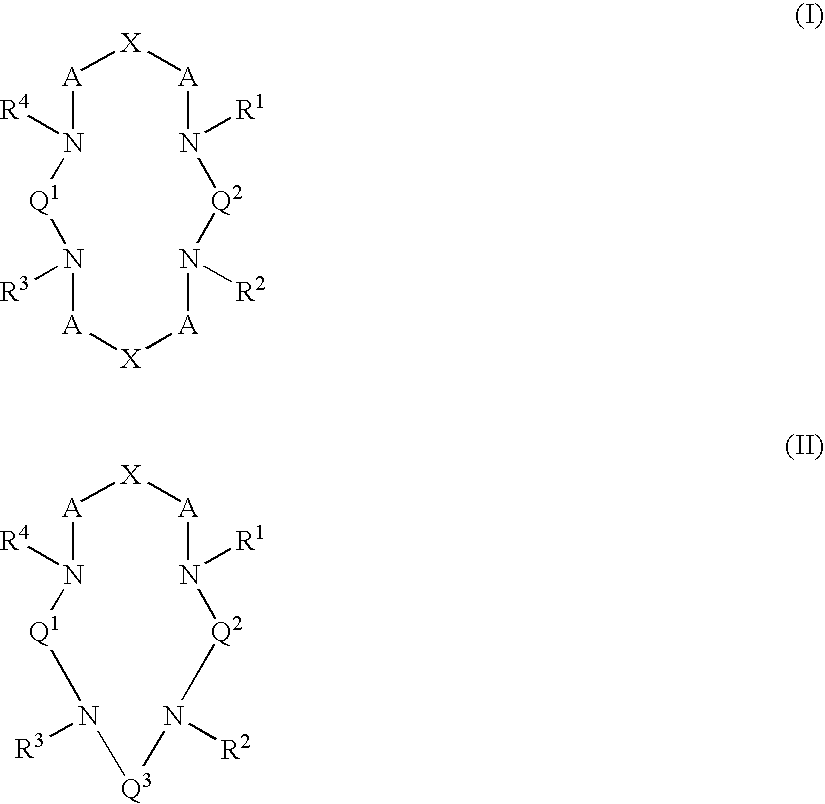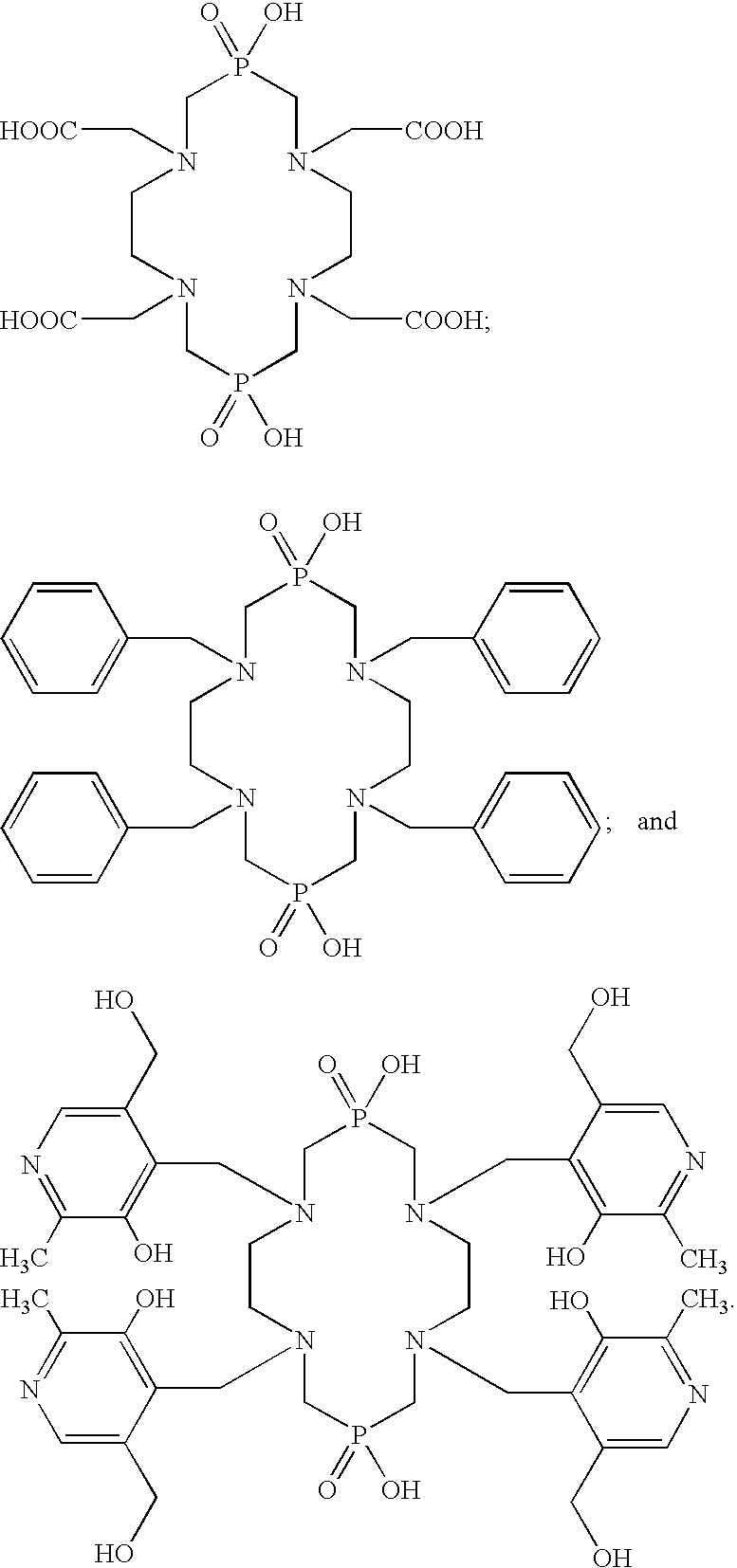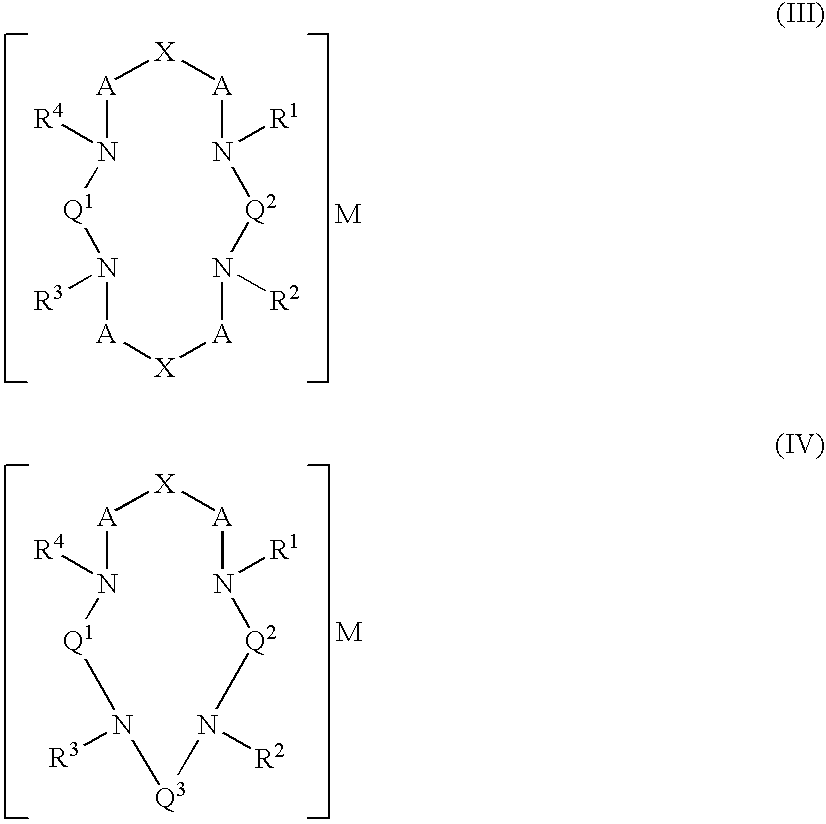Macrocyclic chelants for metallopharmaceuticals
a technology of applied in the field of new macrocyclic chelants and metal chelates, can solve problems such as breakage of these complexes, and achieve the effect of high binding affinity to bon
- Summary
- Abstract
- Description
- Claims
- Application Information
AI Technical Summary
Benefits of technology
Problems solved by technology
Method used
Image
Examples
examples
[0343]N,N-Dibenzylethylenediamine, ethylenediamine-N,N′-diacetic acid, paraformaldehyde, phosphinic acid, and pyridoxal hydrochloride were purchased from Aldrich. N,N′-bis(pyridoxyl)ethylenediamine was prepared by reduction of N,N′-bis(pyridoxylidene)ethylenediamine with potassium borohydride according to the literature (Inorg. Chem. 1994, 23, 1188-1192).
[0344]Instruments. 1H NMR spectra were recorded on a 270 MHz Bruker spectrometer. The 1H NMR data were reported as δ (ppm) relative to TMS. Electrospray MS analyses were performed using a VG Quattro mass spectrometer. LC-MS spectra were collected using a HP1100 LC / MSD system with API-electrospray interface. The high-performance liquid HPLC methods used a Hewlett Packard Model 1090 instrument with radiometric detector using a sodium iodide probe.
example i
Synthesis of TETA(PO)2
[0345]
[0346]Ethylenediamine-N,N′-diacetic acid (3.4 g, 19.3 mmol) was suspended 6 N HCl (50 mL), and the resulting mixture was heated to 105-110° C. under vigorous stirring. Paraformaldehyde (2.8 g, 93 mmol) was then added to give a clear solution. Phosphinic acid (2 mL of 50% aqueous solution, 19.3 mmol) was added in four equal portions over 15-20 min. The reaction mixture was heated to reflux for 3-4 hours, during which time a white precipitate formed. The reaction mixture was allowed to cool at room temperature. The white solid was separated by filtration, washed with 6 N HCl (5 mL), and acetone (5 mL), and dried under vacuum overnight. The yield was 0.43 g. 1H NMR (in D2O+KOD, chemical shift δ in ppm relative to TMS): 3.53 (s, 8H, NCH2COOH); 3.44 (s, 8H, NCH2CH2N); 3.27 (d, 8H, NCH2P, JH-P=12.9 Hz). 31P NMR (chemical shift δ in ppm relative to phosphoric acid): 24.8 ppm. Electrospray MS: m / z=531.3 for [M−H]−1 (M=C16H30N4O12P2), 265.1 for [M−2H]−2, 132.0 for...
example ii
Synthesis of TETB(PO)2
[0347]
[0348]N,N-Dibenzylethylenediamine (4.86 g, 19.3 mmol) was slowly added to a 6 N HCl solution (50 mL) to give a white slurry. The resulting mixture was heated to 105-110° C. under vigorous stirring. Paraformaldehyde (2.8 g, 93 mmol) was then added to give a clear solution. Phosphinic acid (2 mL of 50% aqueous solution, 19.3 mmol) was added in four equal portions over 15-20 min. The reaction mixture was heated to reflux for another 60 min, and was allowed to cool at room temperature, and was then filtered. The filtrate was evaporated to give a white solid, which was then recrystallized from acetone / methanol. The white solid was dried under vaccum overnight to give 4.5 g of the product (70% based on N,N-dibenzylethylenediamine). Electrospray LC / MS (negative mode): m / z=659.2 for [M−1]−(C36H45N4O4P2) and 329.2 for [M−2]2−. 1H NMR (in D2O, chemical shift δ in ppm): 3.36 (d, 8H, PCH2), 3.70 (s, 8H, CH2CH2), 4.40 (s, 8H, PhCH2), and 7.00-7.38 (m, 20H, C6H5).
PUM
 Login to View More
Login to View More Abstract
Description
Claims
Application Information
 Login to View More
Login to View More - R&D
- Intellectual Property
- Life Sciences
- Materials
- Tech Scout
- Unparalleled Data Quality
- Higher Quality Content
- 60% Fewer Hallucinations
Browse by: Latest US Patents, China's latest patents, Technical Efficacy Thesaurus, Application Domain, Technology Topic, Popular Technical Reports.
© 2025 PatSnap. All rights reserved.Legal|Privacy policy|Modern Slavery Act Transparency Statement|Sitemap|About US| Contact US: help@patsnap.com



